Pound Cake Recipe
This post may contain affiliate links. Read my full disclosure policy.
Looking for the perfect pound cake? This is the one! Enjoy it on its own or with a dollop of whipped cream and fresh berries.
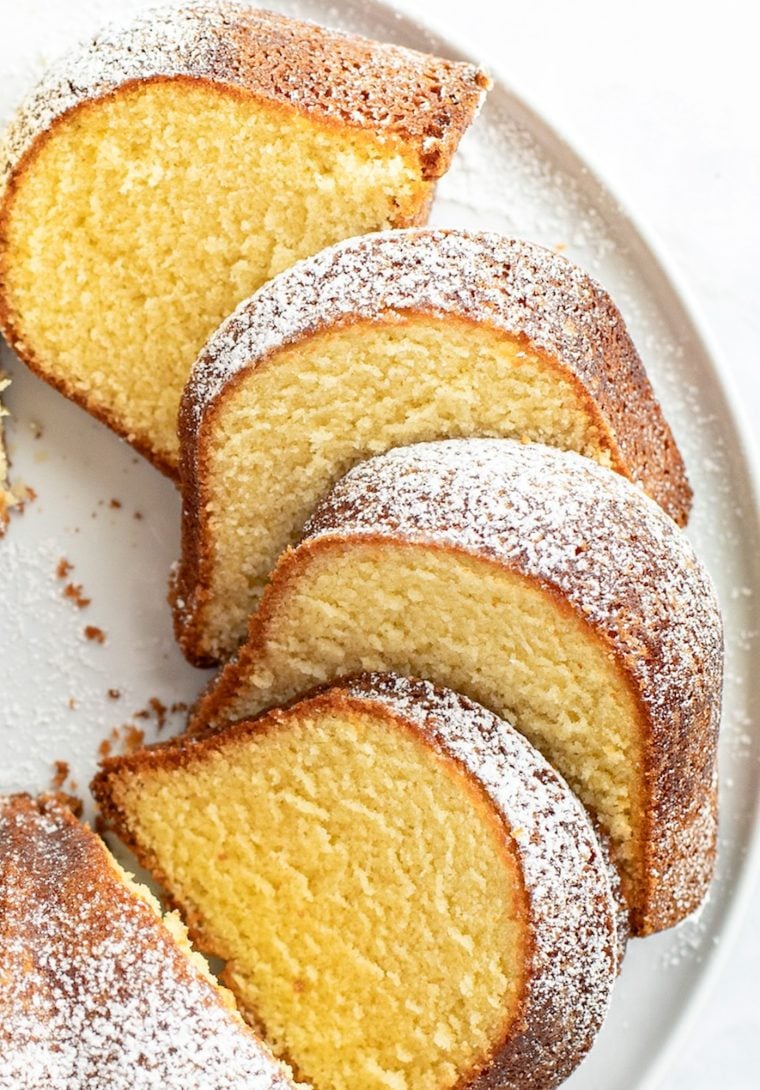
Old-fashioned pound cakes—named for their ingredients, traditionally a pound each of butter, sugar, flour, and eggs—can be heavy and dense. But not this one! The magic lies in the balance of ingredients and the mixing method. Instead of creaming the butter and sugar as you would with most pound cake recipes, this version uses the “reverse creaming” method. By mixing the butter into the dry ingredients before adding the wet, you get a finer crumb and a tender, moist texture. It’s wonderful on its own but even better with a dollop of whipped cream and fresh berries. You can also switch up the flavors—a teaspoon or two of citrus zest or your favorite spices would be a delicious addition. And if you’re craving chocolate, don’t miss my chocolate Bundt cake.
What You’ll Need To Make Pound Cake

- Eggs: Provide structure, moisture, and richness. The proteins in eggs help bind the ingredients together, while the fat adds tenderness.
- Buttermilk: Adds moisture and a slight tangy flavor.
- Vanilla Extract: Enhances the flavor of the cake, giving it a warm and sweet aromatic note.
- All-Purpose Flour: Forms the base of the cake, providing structure.
- Granulated Sugar: Adds sweetness and helps to create a tender crumb.
- Baking Soda: Acts as a leavening agent, helping the cake rise by reacting with the acidity in the buttermilk. (In contrast, baking powder is typically used in recipes that don’t contain acidic ingredients.)
- Salt: Enhances the flavor of the cake by balancing the sweetness and bringing out the flavors of the other ingredients.
- Butter: Adds richness, flavor, and moisture.
- Confectioners’ Sugar: Used for dusting the finished cake.
- Jump to the printable recipe for precise measurements
Step-by-Step Instructions
Preheat the oven to 350°F and set an oven rack in the lower third of the oven. Spray a 12-cup Bundt pan with nonstick spray with flour, such as Baker’s Joy or Pam with Flour.
In a large bowl, combine the eggs, buttermilk, and vanilla.

Whisk until evenly combined. Set aside.

In the bowl of an electric mixer fitted with the paddle attachment or beaters, add the flour, sugar, baking soda, and salt. Mix on low speed until evenly combined, about 1 minute.

Add the butter.

Mix on low speed for 2 minutes, until the ingredients are well-combined and crumbly.

Add one-third of the egg mixture.

Mix on low speed until incorporated. Increase the speed to medium and mix for 2 minutes. Repeat with the remaining egg mixture in two more additions, mixing on low speed to incorporate each addition before increasing to medium and beating for 2 minutes each time. Scrape down the bowl as needed. The batter may look slightly curdled; that’s okay.

Scrape the batter into the prepared Bundt pan and smooth the top. (Alternatively, you can pour the batter into two 8×4½” loaf pans. If using loaf pans, the baking time may be slightly shorter; start checking for doneness at around 50 minutes.)

Bake for 55 to 65 minutes, or until the cake is golden-brown and a toothpick inserted halfway between the side of the pan and the central tube comes out clean.

Cool the cake on a cooling rack for 10 minutes, then invert onto a rack to cool completely. Dust with powdered sugar, if desired, then slice (a serrated knife works best). Serve with fresh fruit, if you like.

Understanding The Method
You might wonder why this cake is mixed differently than your typical cake. Mixing the dry ingredients with the fat first—a technique known as the “high-ratio method” or “reverse creaming method”—helps create a fine, tender crumb and a light, airy texture in the cake. By coating the flour with fat, we minimize gluten formation, preventing a tough texture. Adding the liquid ingredients in stages then helps to create an emulsion that incorporates more air into the batter, resulting in a moist and fluffy cake. This method produces a texture similar to fluffy store-bought cake mixes, which is nearly impossible to achieve with the traditional creaming method.

Make-Ahead Instructions
Pound cake is best made on the day of serving but it can be stored at room temperature, loosely covered with foil or in a cake dome, for up to 3 days. Pound cake can also be frozen for up to 3 months. To freeze, wrap the cake or individual slices tightly in plastic wrap, then place them in a freezer-safe bag or container. When you’re ready to enjoy it, let the cake thaw in the refrigerator overnight. To revive the texture after storing or freezing, you can warm slices in a low oven.
You May Also Like
Pound Cake
Ingredients
- 6 large eggs, at room temperature
- 1 cup buttermilk (see note)
- 2 teaspoons vanilla extract
- 2¾ cups all-purpose flour, spooned into measuring cup and leveled-off
- 2¾ cups granulated sugar
- ½ teaspoon baking soda
- ¾ teaspoon salt
- 2 sticks unsalted butter, softened
- Confectioners’ sugar, for dusting (optional)
Instructions
- Preheat the oven to 350°F (175°C) and set an oven rack in the lower third of the oven.
- Spray a 12-cup Bundt pan with nonstick spray with flour, such as Baker’s Joy or Pam with Flour.
- In a large bowl, whisk the eggs, buttermilk, and vanilla until evenly combined. Set aside.
- In the bowl of an electric mixer fitted with the paddle attachment or beaters, add the flour, sugar, baking soda, and salt. Mix on low speed until evenly combined, about 1 minute. Add the butter and mix on low speed for 2 minutes, until the ingredients are well-combined and crumbly.
- Add one-third of the egg mixture and mix on low speed until incorporated. Increase the speed to medium and mix for 2 minutes. Repeat with the remaining egg mixture in two more additions, mixing on low speed to incorporate each addition before increasing to medium and beating for 2 minutes each time. Scrape down the bowl as needed. The batter may look slightly curdled; that’s okay.
- Scrape the batter into the prepared Bundt pan and smooth the top. Bake for 55 to 65 minutes, or until the cake is golden-brown and a toothpick inserted halfway between the side of the pan and the central tube comes out clean.
- Cool the cake on a rack for 10 minutes, then invert onto a rack to cool completely. Dust with confectioners' sugar before serving. A serrated knife works best for slicing.
Notes
Nutrition Information
This website is written and produced for informational purposes only. I am not a certified nutritionist and the nutritional data on this site has not been evaluated or approved by a nutritionist or the Food and Drug Administration. Nutritional information is offered as a courtesy and should not be construed as a guarantee. The data is calculated through an online nutritional calculator, Edamam.com. Although I do my best to provide accurate nutritional information, these figures should be considered estimates only. Varying factors such as product types or brands purchased, natural fluctuations in fresh produce, and the way ingredients are processed change the effective nutritional information in any given recipe. Furthermore, different online calculators provide different results depending on their own nutrition fact sources and algorithms. To obtain the most accurate nutritional information in a given recipe, you should calculate the nutritional information with the actual ingredients used in your recipe, using your preferred nutrition calculator.


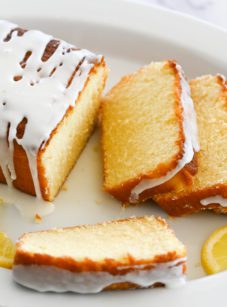
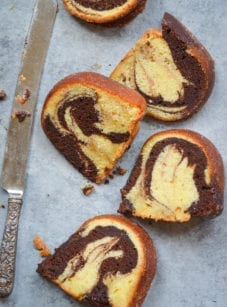
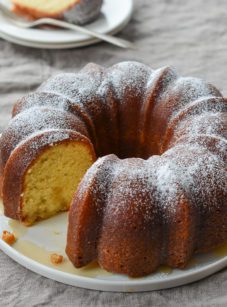
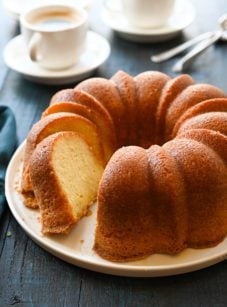
If I half the ingredients, what size cake pan should I use?
Thanks
Hi Jennifer, I would use an 8.5 x 4.5 inch loaf pan. Enjoy!